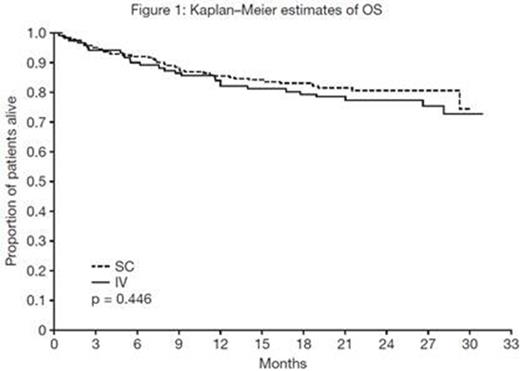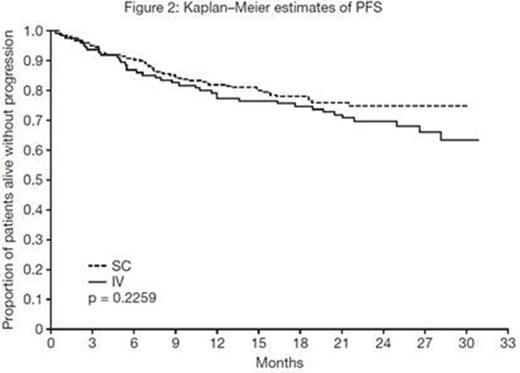Abstract
Background
BTZ is approved for the treatment of MM via either SC or IV administration. The observed non-inferior efficacy (overall response rate after 4 cycles) and tolerability with SC administration of BTZ as reported in relapsed/refractory MM (Moreau et al Lancet Oncol 2011) has the potential to impact treatment outcomes in the clinical setting. However, there is a paucity of comparative effectiveness data on SC vs IV BTZ as initial therapy in MM in clinical practice. The main objective of this study was therefore to evaluate the treatment outcomes in NDMM pts who received SC vs IV BTZ in the US community oncology setting.
Methods
NDMM pts aged ≥18 yrs who received BTZ-based treatment within the McKesson Specialty Health/US Oncology Network between Jan 1 and Dec 31, 2012, and had ≥2 MM-related visits and ≥6 mos' follow-up through Jul 2014, were evaluated. Data were collected via the iKnowMed electronic health records database and supplemented with medical chart reviews. Cohorts stratified by route of administration were matched 2:1 as the Moreau study, and by age, gender, practice region, and performance status. Chi-square analysis (categorical variables), t-tests/non-parametric Mann-Whitney tests (continuous variables), and Kaplan-Meier methodology were employed. Univariate and multivariate Cox models adjusted for clinically relevant covariates were used for associations between cumulative BTZ dose and treatment outcomes.
Results
372 NDMM pts who received BTZ were included; 248 received SC and 124 IV BTZ. Similar baseline demographics and clinical characteristics were observed in the SC and IV groups (Table 1). Median BTZ treatment duration was 4.4 and 4.1 mos in the SC and IV groups, respectively (p = 0.21). Among pts receiving SC and IV BTZ, 10% and 13% had dose reductions in the first 16 wks (p = 0.41) and the median time to dose reduction was 49 d in both groups. While observed median relative dose intensities were similar between the SC and IV groups (1.0 [range 0.67-1.2] vs 1.0 [0.5-1.3]; p = 0.89), a higher median cumulative BTZ dose of 25.8 mg/m2 (1.3-208.6) was observed in SC pts, vs 22.9 mg/m2 (1.3-105.9) in IV pts (p = 0.08). When dichotomized by median cumulative BTZ dose (24.7 mg/m2), a numerically greater proportion of SC pts vs IV pts received the higher dose (52% vs 48%, p = 0.38). Higher cumulative dose was associated with longer PFS and better response rate at cycle 4 (12 wks) in multivariate analyses (Table 2). Treatment outcomes were comparable between SC and IV BTZ; 2-yr overall survival (OS) was 81% vs 78% (Fig 1); 2-yr progression-free survival (PFS) was 75% vs 70% (Fig 2). In 204 response-evaluable pts (of 372 in the overall population with a median follow up of 19.1 mos [range 0.1-30.1] in SC pts and 20.8 mos [0.3-30.8] in IV pts), complete response/very good partial response rate was 16% vs 22%. Documented rates of adverse events in the SC vs IV BTZ groups were 34% vs 28% neuropathy (p = 0.27), 13% vs 10% thrombocytopenia (p = 0.57), 10% vs 5% neutropenia (p = 0.09), and 25% vs 24% anemia (p = 0.87).
Conclusions
The observed non-inferior treatment outcomes between SC and IV BTZ in NDMM pts are consistent with findings from the phase 3 relapsed/refractory MM trial. In addition, SC vs IV BTZ was associated with a trend towards higher cumulative dose, which was associated with improved response rate and PFS. These findings support extended therapy for higher cumulative dosage and better treatment outcomes as demonstrated in a prior phase 3 clinical trial (Benboubker et al NEJM 2014).
NDMM Pt Baseline Demographics and Clinical Characteristics
| . | BTZ SC (N = 248) . | BTZ IV (N = 124) . | p value . |
|---|---|---|---|
| Median age at diagnosis, yrs (range) | 66 (32-90+) | 68 (36-88) | 0.87 |
| Age at diagnosis ≥65 yrs, % | 57 | 60 | 0.55 |
| Male % | 56 | 56 | 1.00 |
| IgG / IgA / light chain / other or unknown MM, % | 53 / 21 / 22 / 4 | 41 / 30 / 23 / 6 | 0.28 |
| Pts with available ISS stage I / II / III disease, % | n = 145 22 / 43 / 34 | n = 64 17 / 33 / 50 | 0.12 |
| Peripheral neuropathy, % | 4.4 | 3.2 | 0.78 |
| . | BTZ SC (N = 248) . | BTZ IV (N = 124) . | p value . |
|---|---|---|---|
| Median age at diagnosis, yrs (range) | 66 (32-90+) | 68 (36-88) | 0.87 |
| Age at diagnosis ≥65 yrs, % | 57 | 60 | 0.55 |
| Male % | 56 | 56 | 1.00 |
| IgG / IgA / light chain / other or unknown MM, % | 53 / 21 / 22 / 4 | 41 / 30 / 23 / 6 | 0.28 |
| Pts with available ISS stage I / II / III disease, % | n = 145 22 / 43 / 34 | n = 64 17 / 33 / 50 | 0.12 |
| Peripheral neuropathy, % | 4.4 | 3.2 | 0.78 |
Regression analyses (RA) for association with cumulative BTZ dose, high vs low (> or < 24.7 mg/m2)
| . | Univariate analysis . | Multivariate analysis . | ||
|---|---|---|---|---|
| . | OR (95% CI) . | p value . | OR (95% CI) . | p value . |
| Objective response* at cycle 4 | 1.67 (0.86, 3.24) | 0.13 | 2.20 (1.01, 4.80) | 0.047 |
| HR (95% CI) | HR (95% CI) | |||
| PFS† | 0.41 (0.27, 0.62) | <0.0001 | 0.34 (0.22, 0.54) | <0.0001 |
| . | Univariate analysis . | Multivariate analysis . | ||
|---|---|---|---|---|
| . | OR (95% CI) . | p value . | OR (95% CI) . | p value . |
| Objective response* at cycle 4 | 1.67 (0.86, 3.24) | 0.13 | 2.20 (1.01, 4.80) | 0.047 |
| HR (95% CI) | HR (95% CI) | |||
| PFS† | 0.41 (0.27, 0.62) | <0.0001 | 0.34 (0.22, 0.54) | <0.0001 |
*Logistic RA
†Cox RA
Rifkin:Celgene: Consultancy, Membership on an entity's Board of Directors or advisory committees; Millennium Pharmaceuticals, Inc., Cambridge, MA, USA, a wholly owned subsidiary of Takeda Pharmaceutical Company Limited: Consultancy, Membership on an entity's Board of Directors or advisory committees; Onyx Pharmaceuticals: Consultancy, Membership on an entity's Board of Directors or advisory committees. Ma:Millennium Pharmaceuticals, Inc., Cambridge, MA, USA, a wholly owned subsidiary of Takeda Pharmaceutical Company Limited: Employment. Harrell:McKesson Specialty Health: Employment. Zhu:Millennium Pharmaceuticals, Inc., Cambridge, MA, USA, a wholly owned subsidiary of Takeda Pharmaceutical Company Limited: Employment. Dow:Millennium Pharmaceuticals, Inc., Cambridge, MA, USA, a wholly owned subsidiary of Takeda Pharmaceutical Company Limited: Employment; Takeda: Equity Ownership. Niculescu:Millennium Pharmaceuticals, Inc., Cambridge, MA, USA, a wholly owned subsidiary of Takeda Pharmaceutical Company Limited: Employment. Bonthapally:Millennium Pharmaceuticals, Inc., Cambridge, MA, USA, a wholly owned subsidiary of Takeda Pharmaceutical Company Limited: Employment.
Author notes
Asterisk with author names denotes non-ASH members.



This feature is available to Subscribers Only
Sign In or Create an Account Close Modal